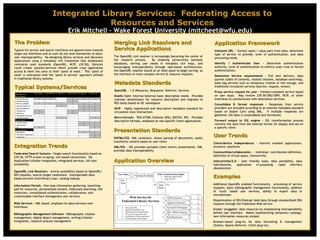
Resource
- 1. Integrated Library Services: Federating Access to Resources and Services Erik Mitchell – Wake Forest University (mitcheet@wfu.edu) Merging Link Resolvers and Service Applications The OpenURL Link resolver is increasingly becoming the center of the research process. By enabling connectivity between databases, serving user needs in metadata rich ways, and encouraging interoperability through web-based architectures, the OpenURL resolver stands at an ideal place to begin serving as the interface to more complex service & resource requests. Metadata Standards OpenURL - 1.0 (Resource, Requestor, Referrer, Service) Dublin Core –Internal/external basic description needs. Provides common denominator for resource description and migrates to RSS easily based on DC namespace NCIP – Highly regimented and descriptive metadata standard for circulation style interactions Micro-formats – RSS/ATOM, Endnote (RIS), BibTeX, RSS – Portable descriptive formats, emphasis on non-specific client applications Typical Systems/Services Examples Additional OpenURL enabled functionality – processing of service requests, basic bibliographic management functionality, addition of ‘trust’ based user services, ability to export data in microformats Dissemination of RSS/Podcast feed data through standardized SRU requests through the Federated Web service Enable ‘pluggable’ data resources by emphasizing interoperability behind user interface. Makes implementing temporary catalogs, new information resources simpler Browser-based plug-ins for data harvesting & management (Zotero, Openly Referrer, COinS plug-ins) Integration Trends Federated Search Systems - Single-search functionality based on Z39.50, HTTP screen-scraping, xml based connections. De-duplication/citation integration, integrated services, full-text availability OpenURL Link Resolvers - Article availability based on OpenURL/DOI requests, source/target resolutions. Interoperable data-based services (Interlibrary Loan, catalog lookup) Information Portals - One-stop information gathering, launching pad for resources, personalized content, federated searching, link resolution, consolidated authentication, collaboration, and customizable interface homogenous user services Web Services - XML based, emphasis on data/services over interfaces Bibliographic Management Software - Bibliographic citation management, digital object management, writing/citation integration, research process management Presentation Standards XHTML/CSS –XML compliant, allows parsing of documents, easily transforms content based on user client XML/XSL – XSL provides portable client centric presentation, XML provides data interoperability Application Framework Interpret URL - Extract name / value pairs from data, determine type of service to provide, level of authentication, and data processing needs. Identify / Authenticate User - Determine authentication authority, level of authentication to enforce (user trust or forced authentication). Determine Service requirements - Full text delivery, data queries (table of contents, related citations, database searching), book bag services such as temporary citation or link storage, and traditional circulation services (borrow, request, renew). Proxy service request for user - Initiate/complete service based on user input. May involve Z39.50/SRU/SRW, NCIP, or other interfaces to communicate with destination services. Consolidate & format responses - Responses from service providers are encoded according to an internal metadata standard based on Dublin Core using XML. If multiple responses are gathered, the data is consolidated and formatted. Forward output to XSL engine - XSL transformation process converts the data from the internal format for display and use on a specific client. The Problem Typical ILS service and search interfaces are geared more towards single-use interfaces and as such do not lend themselves to data/user interoperability. Re-designing library services and discovery applications using a metadata rich framework that emphasizes commonly used standards (OpenURL, NCIP, z39.50), libraries could create systems/services which provide cross application access & meet the users at their ‘point of need.’ This ‘point of need’ is contrasted with the ‘point of service’ approach utilized in traditional library systems. Application Overview User Trends Client/device independence – Internet enabled applications, browsers, platforms Communities/collaboration – individual contribution/definition, definition of virtual space, interactivity Interactivity/2.0 – User friendly tools, data portability, data hybridization, application re-purposing, rapid interface obsolescence
